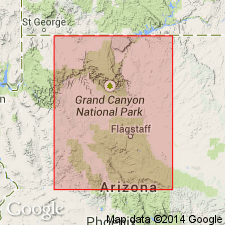
- Usage in publication:
-
- Havasu member
- Modifications:
-
- Original reference
- Dominant lithology:
-
- Limestone
- Dolomite
- AAPG geologic province:
-
- Plateau sedimentary province
Summary:
Pg. 14 (fig. 1), 29, 109-110. Havasu member of Muav formation of Tonto group. Variable in lithology, consisting of mottled, aphanitic limestone in places, and mottled, fine-grained dolomite elsewhere. In general, limestone forms lower beds and dolomite forms upper, but relative positions and amount of each type not constant. Much of the dolomite is red or pink, mottled with tan. Upper limit marked by group of thin carbonate beds. At type locality, forms sheer cliff overlying narrow bench marked by flat-pebble conglomerate. Thickness throughout most of Grand Canyon about 100 feet but in extreme western part averages closer to 120 feet. Top member of formation in Grand Canyon area; younger than Gateway Canyon member (new). Represents the early stage of main regression of the Cambrian sea. No fossils found. Age is considered Middle Cambrian, based on stratigraphic position. Report includes cross sections, measured sections.
Type locality: near mouth of Havasu Canyon, on south side of Kanab plateau, [Tuckup Canyon 15-min quadrangle, Coconino Co.], in Grand Canyon, northwestern AZ.
Source: US geologic names lexicon (USGS Bull. 1200, p. 1704); supplemental information from GNU records (USGS DDS-6; Menlo GNULEX, Denver GNULEX), GNC index card files.
For more information, please contact Nancy Stamm, Geologic Names Committee Secretary.
Asterisk (*) indicates published by U.S. Geological Survey authors.
"No current usage" (†) implies that a name has been abandoned or has fallen into disuse. Former usage and, if known, replacement name given in parentheses ( ).
Slash (/) indicates name conflicts with nomenclatural guidelines (CSN, 1933; ACSN, 1961, 1970; NACSN, 1983, 2005, 2021). May be explained within brackets ([ ]).

